|
-Pastor Melissa Fain- I need to do something a little different today. Tomorrow marks the last day of women’s history month. It came and went without much fanfare. As a form of celebration, and in honor of Lent, I’ve decided to share a few of the pieces I’ve done over the past month, and explain them. You already saw New Creation. As a reminder, it’s a piece that looks at God’s gifts and promises, and whether they can be held by women. It doesn’t answer that question, but simply asks it. But What If She Could?The whole time I was working on the above piece, I was asking the question, "But what if I could?" I knew what I'd draw. First, a transition from day to night. Second, an explosion of light, that can only be properly experienced when started in darkness. This is my imaginary playground. Every once in awhile, I can see the potential- it explodes out. Then I realize it can't happen, and I'm left with the idea, and no way to do it. See, I am constantly living in the world of "what if," knowing there is little more that I can do. I wrote two scriptures into this drawing's foundation. The first is John 1:1- "In the beginning was the Word, and the world was with God, and the Word was God." It tells the viewer this is still a new creation. You can tell from all the chaos that needs ordering. Beautiful new chaos. This image is exciting in it's potential. This image is fun. There's protection too. The "1:1" looks like 7:7- "The world can’t hate you. It hates me, though, because I testify that its works are evil." A little proof texty, I know- but when you have image to tell a story, you have to tell so much with so little. It speaks to Christ taking the burden. God's love made known through the new creation. The second is Luke 13:34- "Jerusalem, Jerusalem. The city that kills the prophets and stones those that are sent to it. How I've longed to gather your children, like a hen gathers her chicks." That turns this drawing against itself. I told you it was potential. Jesus' words were potential too. He's speaking to the potential to care and save Jerusalem, knowing they would crucify him in return. Notice the ground. It's a hidden rainbow. She is standing on God's promise. The rainbow was considered God's war bow, pointed away from the earth, but now she's standing on it. It's so beautiful, but in it's beauty it's sad too. No!When I was a child, I wanted to be part of church. The only way I could, was to light the candles at the beginning of church, and be part of the children's moment. The children's moment, was a 5 minute mini-sermon given before Communion. The kid's would come up. An adult would tell a story, ask a couple of questions, and sometimes we'd get a treat. There came a point, where the adults felt I had aged out of the children's moment. To be fair, I was still a kid- 4th grade. They just decided I was done. The problem was, they couldn't keep me from going to the front of the church. My dad sung in the choir, so no one was there to tell me, "No!" One of the matriarchs took it upon herself to be that person. She took it upon herself to sit next to me one Sunday. When it came time for the children's moment, she firmly told me no. I ignored her, because she wasn't my dad, and started to go up. She grabbed my arm, and tried to hold me back. In shock and fear, I pulled away. That was how the church decided to tell me, and I had multiple nightmares about that event throughout the rest of my childhood. Gals keep other gals from God's promise in a multitude of ways. Maybe it's under the guise of reciprocity. One generation didn't get something, so a future generation shouldn't have it either. Only the previous group can't see it wasn't fair for them, and in turn, it's not fair now. Maybe it's under the guise of justice. "These are the rules and we've been following them for generations." The matriarch was only enforcing the rules, and her sense of justice gave me nightmares about God's house. But, I've seen the guise of justice being used in other ways too. Maybe it's the way the rules are harsher on women in ministry to prove a point. If one can find a single grain of guilt in a sea of ministry, that's it. It's stifling. Or maybe, just maybe, it's the feeling women get that puts ministry as a limited resource. The churches only have so many jobs for women in their building. The media only has one woman they can raise up as their spiritual darling. It forces us to fight one another for something God promised abundantly. We lose sight of the fact that me getting it, helps you get it later. You getting it, is celebration, because you getting it helps us all. We also become far more critical of one another, because we know that failure speaks to all of us, not just the woman who failed. It's painful, and it's real. She Had, and She WillFlipped Mitten Press is a publishing company started by Kristy Burmeister. She used her words to begin to tell the story of trauma suffered through the institution of Church. I made this for her. She is doing it. She took God's promise and made something with it. She will continue to do so. There is nothing in this image, but love. The Word Was GodThis piece is the entire reason all of this exists. I've been spending 12 weeks long-term subbing for high school art class. Whenever I long term sub, I always immerse myself in the content. That's why the pieces look so diverse in their media. With the exception of a few pieces I went home and did because I was inspired, they are all pieces to help me, help the students. This was the first week with Drawing/Painting II. The prompt was "Illuminated pages." While they took on Fairy Tales, I took on John 1:1-4. It's currently hanging in Fig Tree's worship area, and you can see it behind me Sunday mornings. This piece lit the flame to get me to explore how to preach without physical words, but with Word. Dead ChurchOh, I know how uncomfortable this piece is. I can simply explain it, and you should see it differently than you are probably looking at it now. Their are two images fighting for your focus: Communion and Dead Church. Communion was broken and made whole. (Notice the mended cup.) The Church was whole and is now broken. This is an image of focus. What are you going to focus on? The building that will eventually decay and go back to dust? OR The Communion that is eternal? And finally... "Goddess of Life."I want to end here for a couple of reasons:
First, I don't want to end on Dead Church. I find it to be a solid piece, and I love it, but it's dense, and let's end on a lighter note. Second, we're ending on life, and that makes this piece perfect. The image on her brow is one of the Native American symbols for life. There are four quadrants, and each quadrant has four meanings. Child-Youth-Adult-Older Adult Morning-Midday-Afternoon-Night Spring-Summer-Fall-Winter North-South-East-West There is only one type of person who has fully lived in all four: and older person. This person knows all of life. What I love even more are her wrinkles. As we age, our skin creases in ways that show how we lived. This woman laughed! You can tell from her crows feet. -Pastor Melissa Fain- This is a continuing Lenten exploration of non-religious artists' take on religion. This is how I’ve suggested one engages these meditations.
Trust About the Artist:Lorenzo Quinn (1966- ) Son of famous actor, Anthony Quinn, Lorenzo enjoyed a few starring roles himself, before he found his true passion- sculpting. Quinn’s passion is the hands for their technical difficulty. He imbues emotion in his sculptures. About the Art:Trust is about being so trusted by someone, you literally hold them in your hand. My take:When I was in college I used to visit the museum located in the theater building. Sometimes it was student work, and sometimes it was guest artists. This one time, when it was a guest artist, it was an artist who focused on hands. Large hands with tiny people upon them. A person searching, and their tiny arm wrapped around a finger. A bunch of people fleeing a flood, as they run across the palm. These moments of love, hate, fear, and hope. All of them, looking for God and God always there. It captivated me.
This is not that artist. I wasn’t wise enough half a lifetime ago to write that artist’s name down and remember it. I went on an internet search for that artist, and found Quinn in the process. My initial thoughts looking at this sculpture, was looking at a person lying in the hand of God. It was because of this, I couldn’t see how terrifying the hand truly was. It’s not open in acceptance. It’s ready to snatch, or crush. This is seen even more clearly when you compare it to his version of Hand of God. That hand is passive. Trust is a statement of our danger in playing God. How does Trust preach the Word of God to the people of God? -Pastor Melissa Fain- This is a continuing Lenten exploration of non-religious artists' take on religion. This is how I’ve suggested one engages these meditations.
Saved- Link is to watch the movie Saved. It is free on Tubi. About the Artist:Brian Dannelly (1973- ) was born in Germany, and relocated to Baltimore, Maryland at the age of 11. He spent all of his American childhood deep in American religion. He attended a Catholic elementary school, a Baptist high school, and spent his summers at a Jewish Summer camp. He has his degree in filmmaking, and has had many of his short films played around the world. About the Art:Written alongside Michael Urban, Saved was first premiered at the Sundance Film Festival and picked up by MGM/United Artists. It tells the story of a naive girl who attends a very charismatic Christian high school. When her boyfriend confesses he is gay, she decides to sleep with him to help him be straight. When she gets pregnant, she is forced into figuring out where she belongs being a future unwed mother. My Take:I need to give you two takes on this. The first will be my post-high school, but pre-seminary-take back when it was released in 2004. The second will be my mid-life take now.
My 2004 take: When I first watched this I was high on Jesus. I had done a Christian concert tour, taking love offerings to earn money to fix the local Church Camp. I had spent three summers at a Conference Center- working one summer in the kitchen, and the other two as Camp Staff. I had worked at two churches. One- as the Youth Director, and the other as the Youth/Choir Director. I was deep in the system. That’s probably why I was uncomfortable with this movie. I thought it went too far. That wasn’t my experience in the Church. If it were true, it wasn’t related to me, so I could enjoy it as someone else’s condemnation. But… Deep down, I already knew better. I had watched as the church I loved told a couple I loved that they couldn’t be Elders in the church anymore because they felt comfortable enough to come out as a couple. Everyone already knew, but because they verbalized it, they couldn’t do what they were already doing. I listened as a congregant told me they supported women in ministry, but they would never vote for one to be their senior pastor. I should have told her, “If you’re not hiring us to work in your churches, then why are you supporting us to get this very expensive education we have to pay back?” I didn’t. I wasn’t in seminary yet, and I was naive back then. I left it wasn’t going to be my experience. I was going to change the world! I could feel it. Saved came at me with a reflection I was not ready to see. Sure it was true, but from my opinion it wasn’t my truth. Sure, I’d seen the zealotry in the church, but it was over played for laughs. Hilary Faye was the one I knew went too far. She didn’t “get” being a Christian. That was why I decided to like this movie back in 2004. She was a cautionary tale. She was zealotry gone too far. You could be all in for Jesus, and not be Hilary. My 2022 take: When I write that we are all part of the Body of Christ, and all issues in the Church are all of our problems, I’m always recalling this movie in my head. The Church has become so insular. I didn’t realize how much back in 2004, but I’m well aware now in 2022. From the mother winning Top Christian Interior Designer, to the way worship is so jarring and unrelated to the world, this movie is still relevant. Sure, there are points that speak to the late 90’s early 00’s a little better than today, but most of it is very relevant now. How about the pastor who is more concerned with how he appeared to kids, than actually educating and helping them? He’s the one who can’t handle Dean being gay, or Mary (just a little on the nose) being pregnant. Watching this again as a middle-aged, have two kids, ordained as a pastor, adult gave me a new insight. Mary’s mother, Lillian, tries to explain to Mary why Dean was sent to Mercy House. She basically tells Mary that some problems are bigger than a person could handle. Someone else has to fix it. Yet notice it wasn’t Lillian who suggested Mercy House when it is revealed that Mary is pregnant. It’s Pastor Skip. He’s the one who doesn’t have the answers. He’s the one who can’t spiritually justify what’s happening, so it’s easier to take it away rather than deal with it. He’s putting the problem outside the cultural bubble, thus making it disappear. (Kinda like the church did with that amazing couple that came out to a community they thought was family.) His emptiness was on full display. The appearance of relatability was worth more to this community than the reality of relatability. Then there’s the character Hilary Faye. She plays a puppet. Pastor Skip tells her to do something, and she does. This is a girl who has low self-esteem, and just wants to be part of something where she is loved and included. Pastor Skip takes advantage of that to get what he wants. He should be the one talking to Mary and forming a relationship. He should be the one to explain that God loves Faye even if things are not going her way. He should be the one giving authentic lessons instead of pithy sentiments. But he’s not. This movie is also why I’m suddenly silent when people ask me to help them find a church. Do you know there are people who literally walk out of the room when I go to speak? There are many more who will privately tell me they support me, but suddenly go silent when that support requires something a little more public. There are plenty of churches in my county where I do not feel the Spirit. Only 6-8 years ago I listened as a local associate pastor explained that she didn’t go to community pastor meetings because they literally laughed her out of the room! If you like what I’m saying, there is nothing in this county for you. Not really. Sure, there are places you can go into their cultural bubble and fit right in. Just remember you have to leave me and anything I say outside the door. How does Saved preach the Word of God to the people of God? -Pastor Melissa Fain- It’s like Taco Tuesday, but on a Thursday! This is a continuing Lenten exploration of non-religious artists' take on religion. This is how I’ve suggested one engages these meditations.
HOWEVER- This one is a book review. I'll try to keep it spoiler free. I do suggest reading this review AFTER you've read her book. Apologies: A Somewhat Interactive Poetry Experiment About the Author:Kristy Burmeister (1981- ) is me. Well, not “me” me. I feel our life experiences have led us in different directions, but we’d both be likely to follow a similar path if we’d been switched at birth. She is a former Mennonite, and former Catholic. Her journey is one of Church abuse and abuse from men. She has personal experience with #MeToo and #ChurchToo. Her previous published work is Act Normal: Memoir of a Stumbling Block. About the Art:Act Normal is to 1984 as Apologies is to Animal Farm. This is a book that’s meant to be read and experienced from front to back. It evolves as you read it, and if you think you’re just reading a bunch of generally similar poems, you might as well read Animal Farm like it’s Charlotte’s Web. Apologies is made to attack you. Specifically, it’s made to attack those who have experience within the world of organized religion. There are elements that are very similar to children’s bulletins. Children’s bulletins are a single sheet of paper, folded to look like a Church program. It contains Biblical Scripture, and little games to explain the Scripture. That piece of paper serves two purposes: It keeps kids occupied in Church while educating them on something related to Christianity. The difference between Apologies and Children’s Bulletins is while Children’s Bulletins are rather empty in their purpose, Apologies has a very strong point. The interactions in this book should hit you deep. You either get it, or you don’t. My Take:I have a metric ton of feelings on this piece.
Just getting this off my chest- I am so grateful this was published during Lent! We are in the middle of Women’s History Month, and I hear the silence. It's so deafening! Meanwhile, I’m attempting to explore non-religious and artistic views on religion, and it’s all so masculine! Kristy gives me something to explore created by a woman! To the book! About 4 years ago I had this amazing idea. I would ask one of my guy minister friends to do an experiment with me. He would make a feminine minister Reddit username, and I would make a masculine one. Starting at zero karma, we’d set parameters for interaction. Which username would get the most karma by the end of 6 months. Was it the guy minister pretending to be a girl, or the girl minister pretending to be a guy? By this point, I’d been online for about 4 years, and I had a slough of users flat out telling me I couldn’t be called to be a minister because of my gender. I wanted to see. I wanted to see if “calling” was tied to gender. I wanted to test ability with a genderswap. No guy wanted to participate. Why would they?! In the media, guys doing anything that even remotely looks feminine is seen at best as comic relief. My daughter can play a boy in a play without anyone questioning her gender identity, but my son can’t play a girl and get the same result. The double standard is real. All the ministers I asked were super supportive of what I was doing, as long as they didn’t have to actually participate. So I did it all by myself. I made the username, and ran the experiment next to my original username for 6 months. It wasn’t a scientific experiment. I wanted the right people to see what I was doing, and follow it up with a scientific study. What I discovered in that ½ year was that it was easier being a male minister. People simply assumed I was who I said I was. To be clear, I never said I was a guy. My username was masculine and had “pastor” in the title. That was it. No one wondered where I got my education. I was thanked far more often for giving religious opinions. It was like moving from white water rapids, to a smooth flowing creek. There was no way for guys to know how easy they had it, because we don’t consider what doesn’t naturally test us. Out of sight, out of mind. Yet, when I shared what I found, I was called a liar. The guys didn’t step up and support me after the fact either. One even went so far to turn the focus from gender to his topic of discussion. Six months of my life, flushed down the toilet. All that is what I think of as I look at the cover. A “somewhat” “experiment.” No, it’s not a scientific experiment, but still an experiment. When you realize what she did, can you be humble enough to see it was all an act of love? Or- will you turn the story back on you? Or- you will get your feelings hurt and act out in anger? I’m interested in seeing if you even get it! How does Apologies preach the Word of God to the people of God? -Pastor Melissa Fain- This is a continuing Lenten exploration of non-religious artists' take on religion. This is how I’ve suggested one engages these meditations.
Alexamenos Graffito About the Artist: Some Roman idiot with a knife, some time to kill, and a desire to make fun of someone back around 200 AD. About the Art:This is ancient graffiti mocking someone who is a Christian. It is considered the earliest depiction of Christ on record. My Take:First off, I promised non-religious takes on religion. I did not promise it would be “good.” Secondly, I put this piece right up there with The Book of Mormon: the Musical. If you are new here, you might think it’s a dig at Matt Stone and Trey Parker, but that could be further from the truth. As I’ve already written, The Book of Mormon: the Musical was written to be a love song to organized religion. ALL organized religion. It’s a reflection.
We use reflections all the time. Our mirror in the morning tells us if we need to clean up a bit more. The camera on our phone is a reflection of an event we are witnessing. Our problem isn’t reflections, it’s unflattering reflections. South Park actually. I’ve scoured the internet for the title of this episode, so if you know it, comment below and I’ll tag. In the episode, everyone has a social media profile, including Wendy. The only problem is, everyone has a DOCTORED social media profile EXCEPT Wendy. More than that, the kids are judging beauty not by actually looking at the person, but by looking at their altered photo online. Wendy fights it the entire episode, telling everyone that the pictures are fake, but she is real. The episode ends on a terrible downer, as it finally shows her changing out her authentic photo for a doctored one. The whole Christian faith has been doctoring their image for years now. The individuals have kept a squeaky clean profile. Our churches have tucked away the evil and darkness. We have not done a great job simply being true, and because of that, we don’t take truth well. We also look at the truth like it’s all Christ with the head of a donkey. We puff ourselves up, call it trash and walk away. Meanwhile, someone has made a statement that never went away. It exists. It persists. In the case of the donkey-headed-Christ, it is now the oldest depiction of Jesus on record. It’s much more valid to look at it, and learn something from those reflections, especially the ones that are just showing the unflattering visages of us. This is what the Alexamenos Graffito teaches me: Around 200 AD, someone was bold enough in their faith to be the subject of someone else’s boredom. It wouldn’t be until Constantine in the 300’s that being a Christian would be a legal faith. That means Alexamenos is in dangerous territory. Now the viewer has to wonder if Alexamenos was even alive at the creation of this piece, or if he lived much longer after it was finished. We do know that part of the reason Constantine was compelled to legalize Christianity was that the followers by 325 AD were mostly rich and powerful. Now we have to wonder about this man who scratched the image, and was bold enough to write a name. Did he live that much longer after he was finished? This reflection allows us to ask so many questions about early Christians and their faith traditions. About a century and a half after Paul and nearly a century and a half before the council of Nicea. This exists. How does the Alexamenos Graffito preach the Word of God to the people of God? -Pastor Melissa Fain- This is a continuing Lenten exploration of non-religious artists' take on religion. This is how I’ve suggested one engages these meditations.
Vincent VanGogh: Potato Eaters About the Artist:Vincent VanGogh (1853-1890) Was born to an upper middle class family of ministers, artists, and art dealers. He was encouraged to join the family business. He began with art dealing, but was quickly let go, because it didn’t interest him, and he was rude to the customers. He decided to turn to teaching, but failed at getting students. That’s when he became immersed in religion. Taking up his father’s field, he went to University to be trained, only to completely fail at that too. He decided to become a missionary, and was placed in a small coal miner’s town. He connected immediately with the people and their plight. Out of an act of charity, he gave up his missionary lodgings to the homeless, and was fired for it. About the Art:Potato Eaters is the response to being in this small coal town, and being with the people. VanGogh connected with them, and saw them as his people. He focused on art in a way he hadn’t focused on anything else. This was his masterpiece. My Take:With everything going on in Ukraine right now, I’m sure there has been an uptick of people searching for VanGogh’s sunflowers. He painted them all the time. Inside, outside; a couple, a whole field. They were his muse. What the average viewer doesn’t look for is Potato Eaters.
The first time I saw Potato Eaters was on my first date with my now husband, 19 years ago this April. We went to the High Museum of Art in Atlanta. They had a special VanGogh exhibit, and it included a reproduction of Potato Eaters. There was a plaque that proclaimed Potato Eaters to be his finest work of art. I couldn’t see it. I vocally expressed it. I walked over to one of his bedroom paintings and openly said that was better than Potato Eaters. Potato Eaters was so dark! It was so ugly! Give me Sunflowers! Give me Starry Night! Now Starry Night is his masterpiece! How could anyone say anything different? Then I grew up. Well, I grew older. I hope I never really grow up, or if I do it’s seconds before I die. Anyway, I matured, and I learned. To know this piece is so vital to his artistic career, and his conclusion as a missionary, completely changes this piece for me. To now know how difficult it is to control light in a painting, and how technical he was with light, completely changes this piece for me. There is so much going on. This family is in need. You can see it from their sallow faces. You know what they are thinking just from looking. They are all mentally saying, “This is all we have.” They have all come to terms with that fact in their own way. The man on the left is fearful. The woman next to him is thinking an added thought. She is looking at the man and she wants to know what they are going to do about it. Can they do anything about it? The other two? They are older, and hold faces of resignation. This is how it is. This is life. This is truth. The little girl? We cannot know. Only that her innocence will lead to the others eventually. That, by itself, is deep! Then you realize another truth. On the wall is a painting of the Nativity! This is a Christian family, who go to Mass. Where is their church here? What does the Priest’s parsonage look like? Is he forced to only eat potatoes too? Knowing what led to this painting, the answer is no. Then there is the light. This is a coal miner’s family. In the late 19th century coal powered furnaces were a thing. You do not see it in this house. You can tell by their tiny light over the table, and their warm clothing. There is no furnace. You would see light coming from somewhere other than the tiny oil candle. That’s when you know, their work heats someone else’s house. Van Gogh, having been born to a wealthy family, is telling the world why he gave up his missionary home to the homeless with this family. When you understand what is really going on, how can you look at this and ignore their fear and loss?! How can you not see how amazing this painting truly is? How does The Potato Eaters preach the Word of God to the people of God? -Pastor Melissa Fain- This is a continuing Lenten exploration of non-religious artists' take on religion. This is how I’ve suggested one engages these meditations.
Self Portrait of a Young Man (29000.344) About the ArtistRev Howard Fenster (1916-2001)- Born in Alabama, he was one of 16 kids. In 1930, compelled by the Holy Spirit, he took up preaching. To supplement his income, he was also a bicycle repair man. In 1961 he moved to Pennville. It was while he was checking a tire with some white paint, he felt the Spirit again. The paint on his finger looked like a face. He heard the Spirit tell him to paint. Already, he was frustrated because he believed his sermons went in one ear and out another. His only concern was his talent. He heard the Spirit again to do it anyway. That’s when he started his career as a folk artist. His work is almost exclusively sacred in nature. He’s been on album covers, music videos, and late night talk shows. He created over 46,000 individual pieces of art from 1961 until his death in 2001. About the ArtSelf Portrait of a Young Man (29000.344) When you have an artist that has so many pieces to see, what do you focus on? I decided to focus on a very specific self-portrait. This specific self-portrait is more than Rev Finster. This one also includes the Holy Spirit. “Where?” you might ask. Well, friends, in the words written on his face. Here’s the truth about hearing a message from the Spirit. If you’ve experienced it, you know. Really, that’s it. You can relate to others who have experienced it. There is no way to explain it, except to sound completely and totally nuts. Also, you learn the people who don’t get it, REALLY don’t get it. People think the Spirit’s call is really like picking up a nice hobby, or doing something where you have a natural talent. In reality, the Spirit call is almost never fun, or rewarding for that matter. It’s an act of sacrifice for the sake of the whole Body of Christ. For Howard Fenster it is a wild ride. For many, it’s not. My TakeI felt compelled to include Rev Fenster in this collection of writing, even though he never really stopped being a minister. Then I realized it wasn’t that he never stopped being a minister, it was that he never pushed against the corporate church beyond basically saying congregants' memories were easily lost. He wanted to preach in a way that would be lasting. He felt called to leave the church and paint his sermons.
I won’t lie. I was smug as hell when I first saw his work. First, I thought his theological reflections were adolescent. You saw them, and there they were. There wasn’t any deeper meaning. Second, I thought his artistic style was too simplistic. I could do that in a day, and not even blink. The final thought I’ll share after I tear down my first and second thoughts first. He wanted to preach in a way people would remember. Of course his messages had to be simple! What I want to do is different. I want to preach in ways that can’t be conveyed in words; messages that can’t be preached at the pulpit. This doesn’t mean I’m not going to let up on critiquing the theological message. A bad theological message can hurt way more than just the person who believes it. I am going to put away my superiority complex to want something deeper from a person who clearly had deep faith. It’s fine that his messages were simple. It’s necessary for his call. His style reminds me of how I used to draw in elementary school. I need to get down off that horse fast. We live in a world where painting hyper-realism is doable. We can use digital media to stop a moment. We can zoom in on said moment, and get variation of color in a way we never could. Really great artists can use these tools to make near photo quality paintings. That is a statement of their skill, not their art. It disheartens people into not even trying. Even Rev Fenster had his moment. He felt called to paint and told God he didn’t have the skill. Why would anyone even want what he’s making? Then he felt called to try anyway, and he did. I feel we need to encourage art in all forms. It not only expands our definitions of art, but it helps people see skill in others. This leads me to my third critique, and one I can’t reorder in my brain. It’s not smug. It’s just the truth. Rev. Fenster was a man. The longer I’m doing this, the more I’m seeing secular religious art being an easier path for men. In fact, the longer I’m doing this, the more I’m seeing women being put in support roles for men, so men can have an easier path. I have quietly been watching other art forms where the men seek help from women, and when the time comes for the women to get the same support? There are crickets.There are not fewer women in these fields because the women are less talented. There are fewer women because that door doesn’t go both ways. This makes even my hopeful expressions of art a bittersweet experience for me. It carries weight, and even a small added weight, wears one down after years of it being chained to you. I basically told a close friend a year or two back: If I have to quit now. That is not a failure. Even the biggest fighters go down during fights. They are not all wins. At some point, you either die or quit. If I quit before I succeed, that might not be my failure either. I was just worn down too much by others to make it. Like the portrait: It’s not my message, it’s God’s, and I’m not vain enough to believe the message would die with me. I am, however, realistic enough to my own limits, and how it is very possible to wear me down to them. I’m saying all this to help you see context when I say, I’m happy for him and his wild ride. I’m saying all this so you understand why I pray, “God, I’d be doing so much better if you hadn’t made me female. Why me?” See, his wild ride might speak to more than just me. At least, that’s what I’m hoping for. You might be chained to your own weight. You are allowed to appreciate someone for what they bring, while also pushing against it. How does Rev Howard Finster preach the Word of God to the people of God? -Pastor Melissa Fain- This is a continuing Lenten exploration of non-religious artists' take on religion. This is how I’ve suggested one engages these meditations.
What makes this piece different, is it's mine. I finished it yesterday. Today's post will look a little different from the other Lenten posts. The Art:I already knew the creators of religious art was oversaturated with men. I thought I'd go outside the church to find artistic expression and I'd find women. Only secular expression of religious themes are still over saturated with men. Basically, I wanted to see what women outside the Church thought about Church, as much as I was seeing what men thought, only I was only finding men. Just look back at all the posts so far. Amazing talent. Awe inspiring work. All men. In my frustration, I picked out one of the artists, and began a feminist critique through art of their work. About the Art: To really get what I'm doing, it is important to see the related piece. In this case, I chose Aaron Douglas's Creation. I love Douglas' work. It looks simplistic, but the way he uses simple shapes, and range is much much more complex than it appears. His Creation, shows a man looking up at the hand of God. It's a white god, and the stars themselves are white. As the viewer I thought, can he have those stars? Probably not. With these illusions to the flood, the rainbow and Father Abraham, it's a deep piece by an agnostic painter. I recently wrote on his piece titled: Noah's Ark. I picked Douglas for my critique for two reasons. First, I want you to look this artist up. I want you to see his work. He lived in the 20's. When he's visualizing segregation, slavery and oppression he's doing it as an African American who know it. He deserves more attention from all audiences. Secondly, my critique of him is the masculinity in all his work. He lived in a time where "man" meant all of humanity. He could stay masculine, and no one would have questioned him. That can't exist today. About the Artist: If I create something I truly love, I'm usually the most upset by it's creation. I've been doing this for almost a decade. There are backlogs of attempts to put myself out there. There are critiques meant to set something broken back to wholeness. I have been met with an echo. We all have. Some of us think our echoes are validation. Nothing changes if people who already agree with us, choose to agree with us more. I've been ordained for a dozen years. Like, literally 12 as of Feb 14th. I've worked in churches and religious systems since 99'. Twice as long as I've been ordained. As long as I don't rock boats, or don't take too much power, I'm safe. Well, I was safe. Well, I was never safe. I sealed my fate in high school when I led a group of fellow teenagers to walk out on the (who would eventually be) the General Moderator for the Christian Church, (Disciples of Christ). We walked out right when he began his sermon because he was hired as the senior minister, and didn't get along with the associate who happened to be a woman and the youth director. No one in the church knew, and not involving the church in a decision like that was my big problem. As time progressed, he was the one who owned the narrative, so the story became twisted. The story became that the associate led a coup d'etat to take down the poor senior minister. Only it appears the walk out did absolutely nothing bad to this minister. His hissy fit, throwing down the gauntlet to say it was him or her, got her fired, and hurt the church for a generation. He did gangbusters! That was my introduction to ministry. This associate was the first time I had seen a woman preach. I saw how she was treated, and I STILL felt called to go into ministry! Getting God's call is not the same as "finding your passion," or "doing what you always wanted to do." A real honest to goodness call will not often get you accolades or high paying jobs. It's taking on things no one wants to support. It's saying things that no one wants to hear. It's preaching to Nineveh. My take:Notice what is the same: There is a person looking up. There is an olive branch next to the person. There is the hand of god. There are stars the same color as the hand of god. The rainbow is hidden in both. There is water. There are squiggly lines.
Notice what is different: Douglas put the entire piece underwater. At least that's how I see it. The bubbles, and the waves tell me this is after Noah's Ark, but before the water's receded. That also puts the person in the chaos, because the uncreated world was in the oceans. That makes it even more poignant that the olive branch stands next to him. What's different is the person's gender and color. The man is black. The woman is white. I'm speaking from my context, and only my context. I'm a white woman. I'm not taking on anything that doesn't belong to me. God is white in Douglas's work, while god is a man in mine. Douglas's man is looking up at god. My woman is looking at a star, and wants to touch it. There is still the illusion to the flood, because Douglas's road was transformed into a creek in mine. I knew I couldn't put bubbles in the sky, so I decided for wind, only my wind became the spirit. Also blue, and completely by accident. It's filled with so much hope. I want her to get the star. I want the Abrahamic promise to belong to her too! Only, I fear the star will never reach her, or if it does she won't be able to use it. This painting is the truth, and what the truth holds depends on what we do with it. How does "New Creation" preach the Word of God to the people of God? -Pastor Melissa Fain- This is a continuing Lenten exploration of non-religious artists' take on religion. This is how I’ve suggested one engages these meditations.
For this art, I’d like to ask you to listen to the song without seeing the imagery. Press play, and don’t watch. Let the music take you in. When you come back to it after reading what I’ve written, watch it. About the Artist:Omar Thomas (1984-) Born in Brooklynn, New York to Guyanese parents, he moved to Boston in 2006 to earn his Masters in Jazz Composition. He won the ASCAP Young Jazz Composers award in 2008. He is hailed for his ability to capture emotional intent in his work. About the Art:Thomas was commissioned by the JMU Wind Symphony to create a memorial piece in remembrance of the 9 lives lost during the 2015 Charleston AME Church shooting. The piece is angry, sad, confused, and ultimately hopeful. It uses the Black National Anthem, Lift Every Voice and Sing, as it’s muse. My take:My undergraduate degree is a BA in Music. Music was my balm when my personal world was a minefield. I sang and played my soul out. That’s why it might surprise you to know that it is extremely difficult to get a song to bring me to tears. I’ve been sad while singing. I’ve cried while singing “Amazing Grace” at a funeral. A few tears slipped while I sang “Let there be Peace on Earth” the Sunday after 9/11. Those were less the songs, and more what was happening for those songs to be played.
Samuel Barber’s Adagio for Strings rips me apart every time. It really doesn’t matter what mood I’m in, or how many times I’ve heard it. The edges of my eyes get misty. I feel it. Now there’s a second. “Of Our New Day Begun” is a mourning wail. It is the musical version of a Lament if I’ve ever heard it. More than that, if you are anywhere in the mourning process, this song sings, and sounds to your specific place in that journey. Maybe it has just begun, and in that case, this song is raw. It plays your nerves like violin strings. Maybe you have finally begun the sacrificial journey, willing to bring what can no longer be before God. In that case, it screams. It is an angry rebuke of a broken creation. Maybe you have found the light after brokenness. You are in the midst of thanksgiving. In that case, it brings out the happy tears. It’s a joyous celebration that something new has been created, while still lamenting what can never be again. This is, in a very real sense, a Lenten song. This is, in a very real sense, a modern Psalm. This is, in a very real sense, what I was talking about with Dr. Pemberton, when I said not all speech uses actual words, or if it does, it’s more about what those words mean, not what they are actually saying. It’s times like this I begin to understand why I felt called to get my dinkey music degree (because a BA in music is a BA in basket weaving without an education focus or something to back it up) was vital to my call as a minister. Seminarians are inundated with words. Ministers study with language. Meanwhile, my first conversations with God lacked vocabulary. Now I’m trying to show you, and I see how difficult it can be to see communication beyond words if you’ve never thought beyond them. Learned back when I was tied to the lyrics of someone else’s song, that the notes sing too. True, they too were someone else’s notes, but they said more than the words. “Of Our New Day Begun” says more than words too. We need only listen. How does this piece preach the Word of God to the people of God? -Pastor Melissa Fain- This is a continuing Lenten exploration of non-religious artists' take on religion. Noah’s Ark https://www.wikiart.org/en/aaron-douglas/noahs-ark-1927 About the artist:Aaron Douglas (1899-1979): Was born and raised in Topeka, Kansas. He was the most influential artist of the Black Harlem Renaissance. In 1924 he moved to Harlem, and continued his art, teaching, and becoming an art critic. His style was within the art deco genre, and synthetic cubism. His bold and simple color pallet uses range to draw attention to specific parts of the painting. About the art:About the art: Noah’s Ark is a classic Biblical story of Noah being the last redeemable person on the Earth, and God saving that person, while destroying the rest of humanity. It is a big do-over. Painting over the canvas to start again. It’s one of those stories that is unbelievably horrific, yet we paint pretty images of the story in our Children’s Bibles and on baby’s nursery walls. My take:Douglas has quickly become one of my favorite artists. It’s because of him that I even chose to take on this project. He is not afraid to use religion to speak to broader stories, especially in the African American context. I love his use of light. You don’t have to have an art degree to know where he has placed the focus. In this piece it’s two-fold. First, there’s the Godlight shining on Noah. You see him giving orders, as the last minute preparations are being made on the Ark. Only, that light doesn’t radiate out. There are two places the light radiates. First, there’s God, stopping short of touching anything but Noah. Nothing is going to stop the rising waters, and you can see them in the background. Devastation is going to come, and God will not stop it. Then there’s the real focus. In the background, if not for the waters, as far back as you can get, there is a worker making last minute fixes to the boat. That man is going to die. In fact, all the people, apart from Noah, are working on their death. The man in the foreground is dragging a log. Perhaps it was a log holding the boat in place. Then there is a man carrying up supplies, or pitch to the boat. All three of them will be dead. That’s when I realized he painted Noah’s Ark to be a slave ship. Noah, in this painting, is not the “good guy” at all, just as God is not a loving God. As Christians, we are told where to focus. How dare we draw our attention to the footnotes or the margins. God and Noah. That’s it. Practically speaking, if Noah’s Ark is to be believed, Noah couldn’t have built that Ark on his own. It was, in the truest sense, slave labor. It was slave labor because none of the workers would have gained any fruit from their hard work. No wonder Noah got stupid drunk after the waters receeded, and it was dry enough to get off the boat. If you’re that Noah, in Douglas’ painting, you would have to see the immense loss you could have prevented had you looked in the shadows. How does Douglas’ “Noah’s Ark” preach the Word of God to the people of God? For another resource:
https://wwwnc.cdc.gov/eid/article/9/1/ac-0901_article |
Categories
All
Archives
October 2023
|



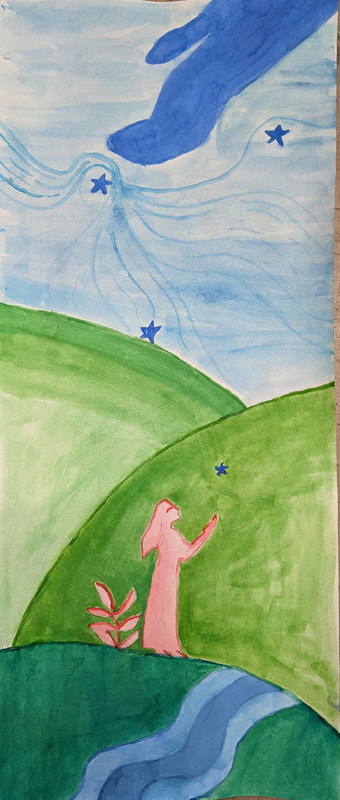
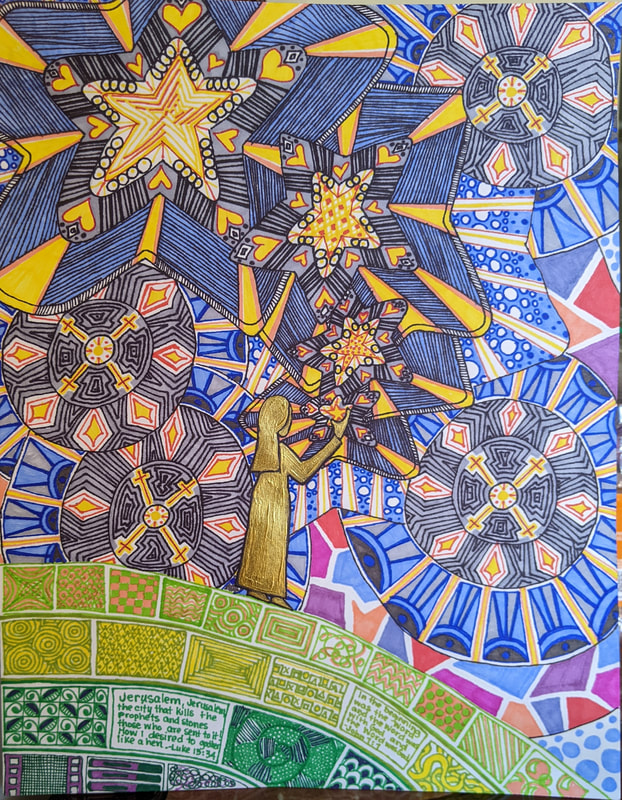
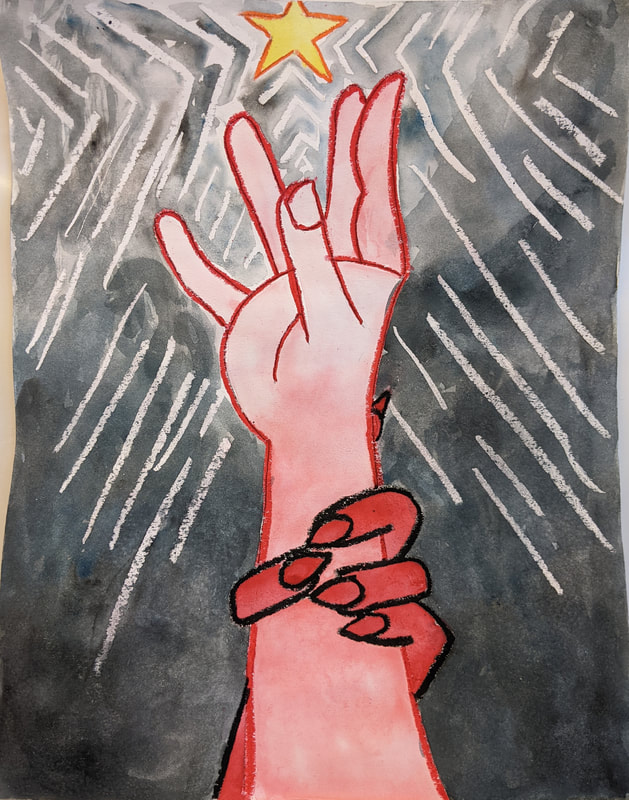
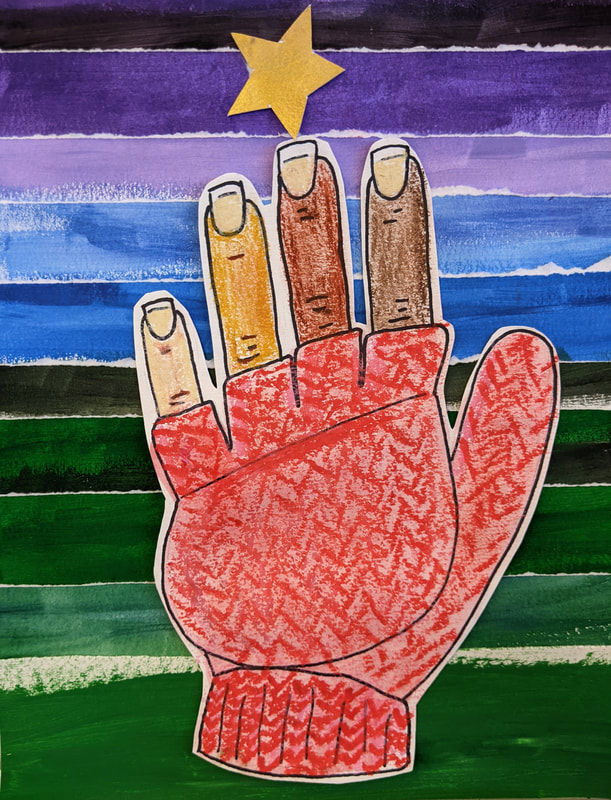
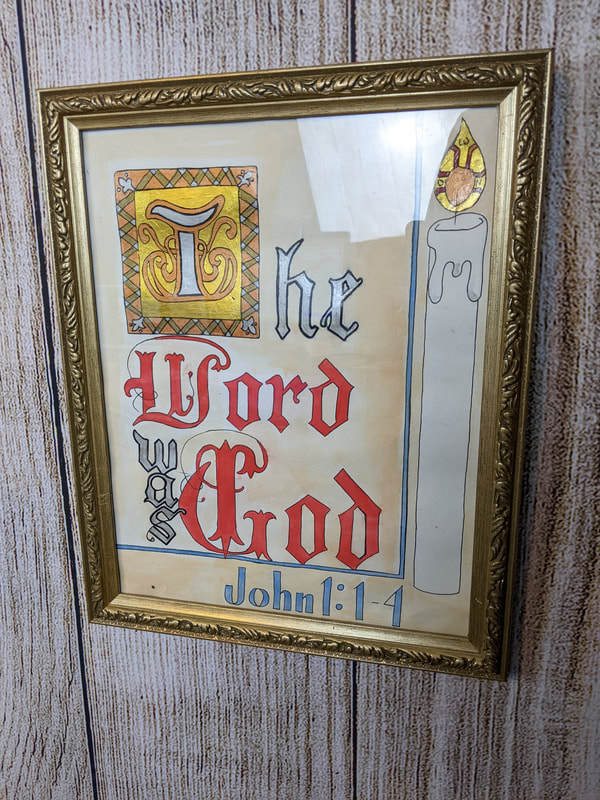
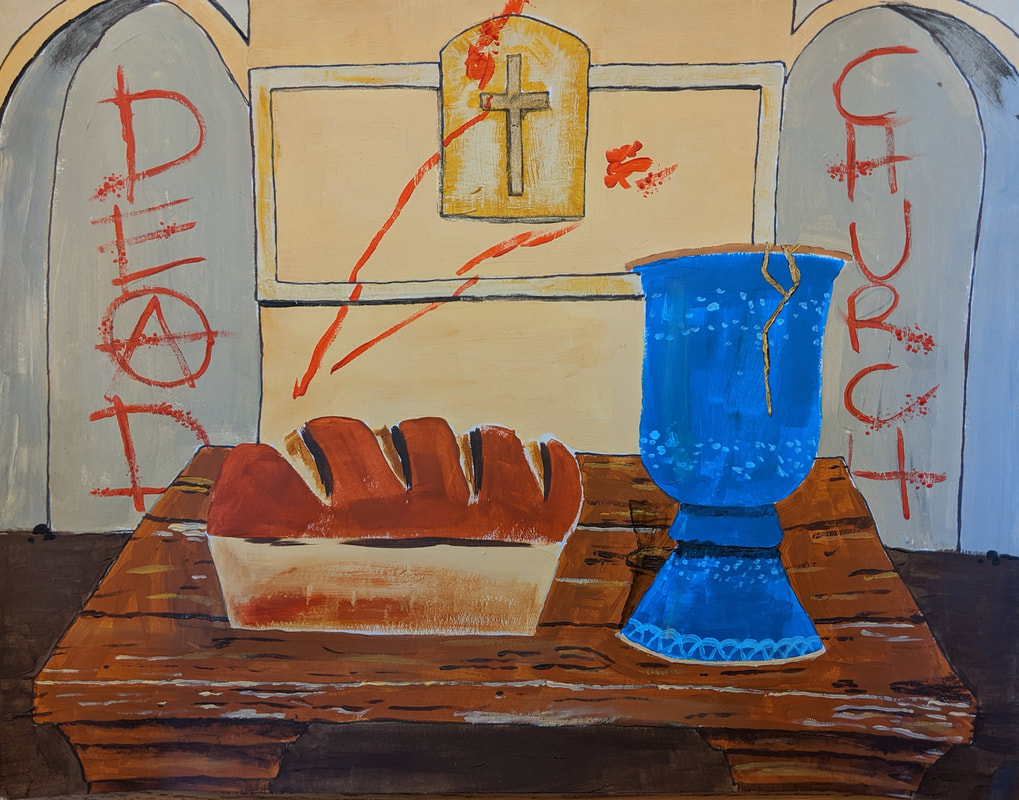
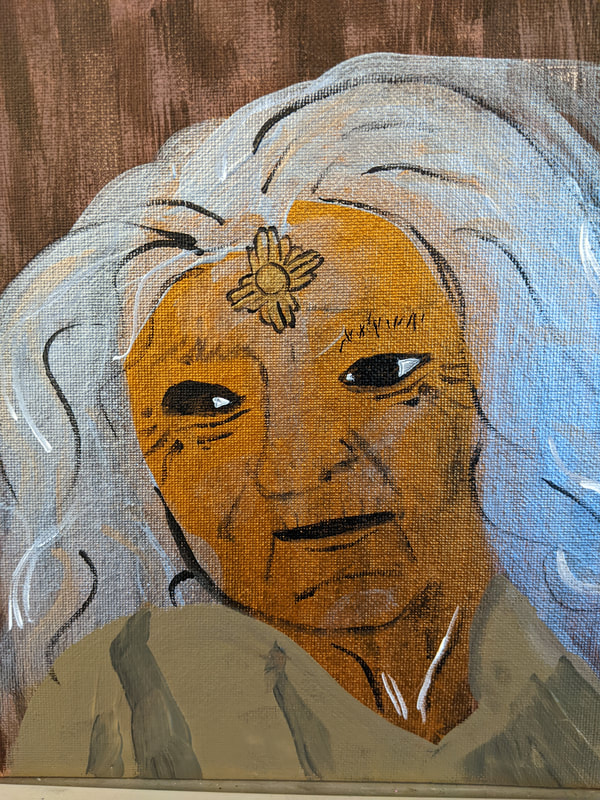

 RSS Feed
RSS Feed